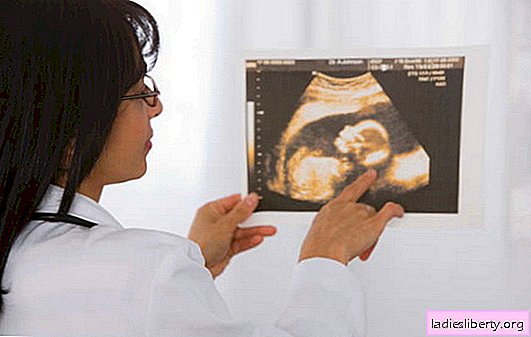
Low water is a lack of amniotic fluid in pregnant women.
They are a kind of water world that surrounds the baby throughout pregnancy.
They begin to appear in the third week of pregnancy, initially their number in relation to the size of the baby is large, which is why he is in complete freedom.
But what contributes to the fact that the amount of amniotic fluid is reduced?
Low water during pregnancy - causes
Low water during pregnancy occurs for many reasons, this can happen even in the early stages.
In any case, it is impossible to ignore such a pathology, since it can lead to serious consequences. So, the causes of low water include the following:
1. Pathology of the kidneys in an infant, oddly enough, but this can lead to the fact that the amount of amniotic fluid becomes significantly less than normal. Such a lack of water, which lies in the pathologies of the fetus, is unfortunately dangerous. Doctors often insist on terminating such a pregnancy.
2. Increased blood pressure in a woman in labor. This usually happens in late pregnancy. The mechanism of the occurrence of this condition is primarily due to a violation of the functions of the placenta.
3. Postponed pregnancy. The placenta is aging, the amount of amniotic fluid decreases.
4. Woman carries twins. In this case, one child may experience low water levels, and the other, on the contrary, polyhydramnios. But such violations practically do not carry any threat.
5. Genital infections. It is not at all necessary that they appeared during the bearing of a child. Even previously untreated diseases can affect the amniotic fluid.
Severe water deficiency will be felt even by a woman. The lower abdomen will constantly hurt. If the child begins to move, discomfort and pain will begin to be felt. This condition is especially felt at 36 - 42 weeks of pregnancy, when the baby is already large.
There are also such cases when the causes of oligohydramnios cannot be determined. But, despite this, experts should still try to find out what caused this condition, as well as take the necessary measures to eliminate the trouble.
Low water during pregnancy - consequences
With oligohydramnios during pregnancy, serious complications can occur. The most dangerous, if oligohydramnios was not detected before 28 weeks, but at the same time it is.
At a period of 15-25 weeks, a miscarriage may occur, and naturally, the baby will die. In addition, specialists have long revealed a direct relationship between oligohydramnios and the presence of congenital malformations in a child, for example, heart disease, renal dysplasia. If amniotic fluid is completely absent in the first or second trimester, doctors strongly recommend calling a premature birth. In this case, the child cannot be saved. But even if he still survives, there is no guarantee that he can live long.
Also, with oligohydramnios, entwining with the umbilical cord may occur, the risk of intrauterine infection increases several times.
If oligohydramnios is severe, small adhesions form in the form of filaments between the skin of the child and the amniotic membrane. This is dangerous because they will begin to wrap around the fetus, the umbilical cord, and eventually tissue necrosis will occur.
A small amount of amniotic fluid can lead to injuries in the baby at the time of birth. For example, a cerebrovascular accident will occur.
With oligohydramnios, weakening of contractions will occur, the most dangerous complication is premature detachment of the placenta.
Due to the lack of amniotic membranes, uterine bleeding may develop, this will require immediate surgical intervention.
There is also a high risk of injuring the cervix during childbirth.
Be careful, listen to your body, and most importantly, have a timely examination in order to identify all the deviations in advance.
Low water during pregnancy - what to do
Quite often, a moderate amount of water (approximately 400-700 ml) is considered the norm. In this case, a pregnant woman should reduce physical activity, eat well, constantly observed by her gynecologist, and also drink multivitamin complexes. In order to further eliminate the decrease in amniotic fluid, you may have an unscheduled ultrasound. If the symptoms of oligohydramnios became more pronounced, and the amount of fluid became less than 400 ml, then you need to be treated in a special department of pathology.
Immediately after a specialist detects a shortage of water in a pregnant woman, she will be sent to the hospital so that she passes all the necessary tests. While in the hospital, the future woman in labor will conduct an additional examination:
• you need to pass additional tests, urine and blood;
• ultrasound;
• CTG.
If the doctor began to suspect that the woman is developing amnionic hydraea (in this condition amniotic fluid leakage occurs), it is necessary to pass a smear on the water.
At a time when a woman is already 38 weeks pregnant and a little more, the cervix begins to gradually prepare for labor, so her channel may well miss an amnioscope. In this case, the gynecologist will be able to determine with absolute accuracy how much amniotic fluid is in the bladder. During this procedure, the integrity of the fetal membrane is not violated, and there is also no threat to the child.
Treatment will directly depend on what reason caused the oligohydramnios:
1. If the cause of this condition is amnionic hydraea, then the woman in labor should observe only bed rest, take vitamins, as well as drugs that will help reduce the tone of the uterus. Most likely, a pregnant woman will have to spend a long time in a hospital, up to childbirth. The condition of the fetus must be constantly monitored.
2. Is water shortage due to a viral infection? In this case, you need to drink antiviral and restorative drugs. Only a doctor prescribes them, since it is necessary to choose exactly those funds that will not harm the baby. In addition, vitamin therapy is needed. If positive dynamics is observed at the entrance to treatment, then the expectant mother may go home for some time, but it is absolutely necessary to monitor her condition. In which case, you can not wait a minute, even if you observe a slight deviation from the previous state, be sure to call an ambulance.
3. Does a future mother have an anomaly of development in the fetal membrane? It is necessary to choose the therapy that, first of all, will help maintain pregnancy, and also prevent intrauterine infection. A woman is constantly diagnosed in order to note the slightest change for the worse or for the better.
4. If a woman passed with a child, the fetal bladder is punctured. After this, labor begins and, as a rule, everything goes well.
If oligohydramnios will be detected on time, and treatment started in a timely manner, then the prognosis for pregnancy is favorable.
Low water during pregnancy: prognosis for childbirth
If the woman in labor is diagnosed with severe oligohydramnios, she undergoes a planned cesarean section. With a small amount of amniotic fluid, the fetal bladder becomes flat. This will affect the contractions, they will become irregular and rather weak, which is why childbirth for a woman will be very difficult and long.
With moderate oligohydramnios, there are no contraindications for natural childbirth. Even if, as a result of a small amount of water, the fetus takes a gluteal or pelvic presentation, childbirth can still pass favorably for both the baby and the woman in labor.
As a result of the fact that the amount of amniotic fluid is small, the baby is deprived of the opportunity to move freely in the womb. That is why he so often takes the wrong presentation, and then simply can not turn correctly.
Experts have developed a whole range of exercises that will help the baby crumble into the correct position, but from a medical point of view their effectiveness has not yet been confirmed. Also, exercises can lead to the occurrence of entwining with the umbilical cord. Before you begin to implement them, you need to think things through. It is not recommended to search for any information on this subject in the forums. After all, even if your baby is in the wrong position, he can still be favorably born. If you fail to have a baby in a natural way, there will be doctors nearby who, if something happens, will have a cesarean section.
Many gynecologists do not recommend wearing a bandage, as it restricts the baby’s movements and can prevent the baby from turning itself.
Quite often, low water during pregnancy leads to premature birth.
Low water during pregnancy is rare, only 3-4 out of a hundred women face such a pathology. But on the forums you can often see that women are actively discussing how to treat this condition. But can you believe everything that I write there? In fact, only a doctor can draw up a treatment plan for a pregnant woman, and it is individual for each case. Carefully monitor your condition, try to be examined more often in order to know how the child feels. And of course, tune in only for the good!











